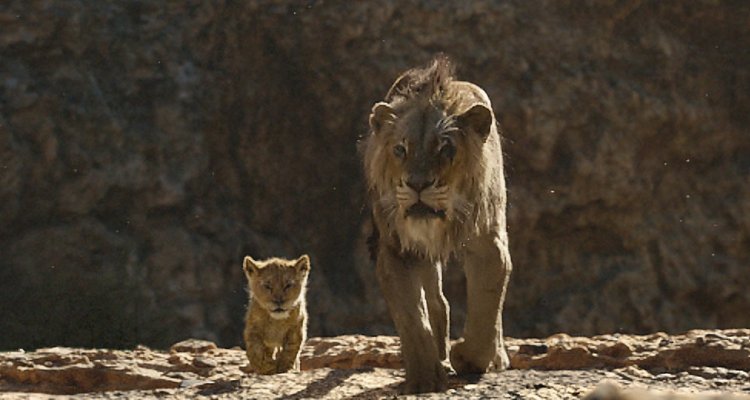It’s one thing to remake “The Jungle Book” into a digital wonder, but another to transform a certified animated classic such as “The Lion King” into a “live-action” CG blockbuster. That’s what the now Oscar-nominated team for Jon Favreau’s adaptation had to consider before they segued to the new production. Basically, how do you tackle something this big when the people closest to you are telling you not to screw it up?
“My kids. that was their first VHS film and they played it over and over and over and over again,” VFX Supervisor Rob Legato says. “That generation, that’s the movie that they remember as a kid.
VFX Supervisor from MPC, Andy Jones added, “My cousins and stuff. I thought, ‘Can’t screw it up.'”
Elliott Newman, the third VFX Supervisor on hand, laughs slightly and admits, “I just said it to myself.”
Unlike “The Jungle Book,” the visual effects team on “The Lion King” had to animate in a completely “live” CG world. That sounds slightly confusing for sure, but the best comparison is to “The Jungle Book” had a real-life lead (Neel Sethi as Mowgli) and a physical environment for him to walk through and interact with the CG characters that populated the film. “The Lion King” did not. Everything was created in a CG environment with the camera moving within it at Favreau’s direction. When it came to bringing the finished product to “life” it turned out hurdles the production needed to overcome in this particular case were more on the backend.
“I think probably one of the biggest technical challenges at least was rendering it,” Newman says. “I think that that was incredibly complex because of the scale of the production. It was a stereo show, every shot contained many furry animals, big, complex landscapes. And, obviously, no plate photography, whereas in ‘Jungle Book’ a lot of the frame was taken by the actual live-action play. Whereas this time around, every pixel in the movie is rendered.”
Newman continues, “That was one of the biggest things for us, just the sheer rendering volume. Everything we pushed, all the technology, the complexity of the fur, how all the materials and the environments respond to light. All of those things just amp up the complexity of the frame that you actually send to be rendered. So it was a constant thing for us to manage as to how to actually make sure it does finish rendering. Because it’s quite easy just to let it carry on forever.”
Jones notes, “Even though computers are going so fast we’re just throwing more and more at them. Everything is range erased, which is a heavy computer computation of every ray of light hitting one thing, bouncing off another, bouncing off of that, bouncing off another one. That takes a while to compute, and when you have a landscape of a mile, it’s trying to do all that. So then [our team] optimized it with that pack system that they had, where you would only render what was seen by the camera.
“So, if a rock blocked some portion of it, you don’t have to render that,” Legato adds. “Think about it. It’s going to take up time real estate that you don’t see.”
Their hard work paid off with “The Lion King” becoming a massive blockbuster earning 1.6 billion worldwide. When the end of year accolades arrived, Favreau and the production team were no doubt hoping for critical love for the film itself, the score, its original songs and their visual effects work. What they were slightly surprised by were the critics’ groups that awarded them Animated Film honors or nominations. Despite losing the Golden Globe Award for Animated Feature the night before our conversation the visual effects team all had different opinions on how close to an animated film “The Lion King” actually is.
“I have a different opinion I think than some,” Legato says. “I mean, our opinion was that we’ve made a live-action looking movie and that’s the way you would describe it if you were to describe the movie to someone else and say, what does it look like? Well, it looks like a live-action film, as opposed to it looking like an animated film. Because I think the term animation gives it a certain connotation that it’s not. Because an animated film is a Pixar film, is the original cartoon. And it usually, even in acting circles, if you say someone’s performance was animated, it’s not necessarily naturalistic.”
Jones has a slightly different take. He notes, “I mean I agree with Rob that our goal was to make it never feels like an animated movie. But in the end, it is a completely keyframe animated movie. So, animators worked on it and a bunch of artists and technicians worked on it. But it’s got a lot of live-action techniques that are mixed into an animated movie, which usually aren’t. So all the ways it’s photographed is a very live-action style. And the background, too. The performers are animated, but the background’s not animated necessarily.”
It didn’t seem prudent to argue that most animated films don’t have backgrounds that are “animated,” but as Newman adds with the most political answer of all, “It’s unique and that’s why it’s fun to have these conversations because it hasn’t been done before.”
And that’s perhaps the number one thing these artists hope Academy members remember. “It hasn’t been done before.”


